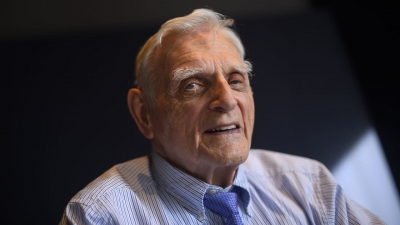
Age is just a number and no one can prove it better than John Bannister Goodenough. Chances are that most of us never heard of this 97-year-old scientist before he became the oldest Nobel laureate, but his invention has became an irreplaceable part of our lives.
Goodenough, a professor at the University of Texas, came up with lithium cobalt oxide, a key material that led to doubling the potential of the lithium-ion battery, widely used in mobile phones, laptops and electric cars.
Early life
Growing up in Connecticut, near Yale University, where his father was a professor of the History of Religion, Goodenough learned to enjoy the quiet countryside and nature. Exploring the neighbourhood on his childhood catching butterflies and trapping rodents-especially woodchucks, a species of large squirrels.
Along with his siblings, Goodenough attended a boarding school in Massachusetts. The future Nobel laureate had a hard time mastering reading and writing; eventually he earned a place at the respected Yale University. After trying out a smorgasbord of courses including liberal arts, he turned his focus on mathematics.
The college fee was $900 per annum and Goodenough’s father could contribute a mere $35. So Goodenough started tutoring students from wealthy homes to be able to pay the rest of the fee.
Adventures in meteorology
Halfway through his education,. Japan attacked Pearl Harbour, a U.S. Navy base near Hawaii. Goodenough volunteered to join the Army as a meteorologists on the advice of his maths professor. Stationed in the Azores archipelago off the coast of Portugal, he helped predict the best time to move troops and planes.
While in the Army, Goodenough took a liking to Physics. So after the war ended, he pursued his further education in his subject. Since he was a returning officer, the Army supported his higher studies, and Goodenough joined the University of Chicago, which was doing pioneering work in the field.
The Physics department at the university was headed by none other than the nuclear physicist Enrico Fermi, who created the world’s first nuclear reactor. A tough taskmaster, Fermi set the bar high for his students with a qualifying exam of 32 hours, stretched over eight hours a day for four days. The exam was so tough that Goodenough could get through only on his second attempt.
Battery-powered
Goodenough was offered a position at MIT’s Lincoln Lab, which was a research centre for the U.S. Department of Defense. He developed technology for national security applications. After decades of work on electric and magnetic properties of solids, he moved to another prestigious academic institution, the University of Oxford in England, as the head of the inorganic chemistry lab.
The next few years would become the most defining of his career. Goodenough immersed himself in battery research and came up with lithium cobalt oxide, a material that could be sustainably and safely used in lithium-ion batteries. Stanley Whittingham, one of the three awardees of the 2019 Nobel Chemistry Prize, had developed the first-ever functional lithium battery in the 1970s, but it ran the risk of exploding. The discoveries of Goodenough and Akira Yoshino, who was the part of the trio to share the Nobel, helped in making the battery safer and viable for use.
While the lithium-ion batteries became a commercial success, Goodenough did not make any money out of it. He did not patent the battery technology and signed over the royalty rights to the Atomic Energy Research Establishment, a U.K. government lab near Oxford. After being tipped for the Nobel Prize for many years, Goodenough finally received the honour on October 9, 2019. When the prize was announced, he was in London to receive the prestigious Copley medal at the Royal Society of London. He slept through the announcement of the Nobel and learned of his win from a fellow scientist.
97 and going strong
Goodenough, who is now just three years shy of 100, goes to the office, his lab, every day. He is vehemently opposed to retirement and never wishes to hang up his boots. Well, that’s Goodenough for us!
Picture Credit : Google

